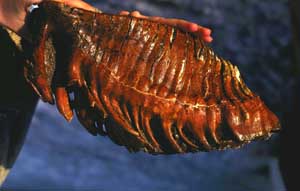|
|
 54 mammoth DHJanzen101187.jpg high resolution
|
|
| And this is a 11,000-year-old woolly mammoth molar from the Fairbanks area. The wear surface is at the top left, worn flat by continued abrasion of grass (probably with lots of sand/dirt mixed in) and small twigs. The molar was migrating from right to left down the jaw, and would eventually have been completely ground off - but by then the next molar will have migrated forward. Imagine the tundra and the black spuce forests and the birch poplar forest trampled and grazed and defecated on by elephant-sized animals. And one of those carcasses could have taken many decades to degrade, and supported many scavengers in the process. Frozen cadavers of these animals are still being found and thawed out of the Siberian and Alaskan tundra, as the permafrost gradually thaws with global climate change. | ||
back to lecture slides
or skip to: